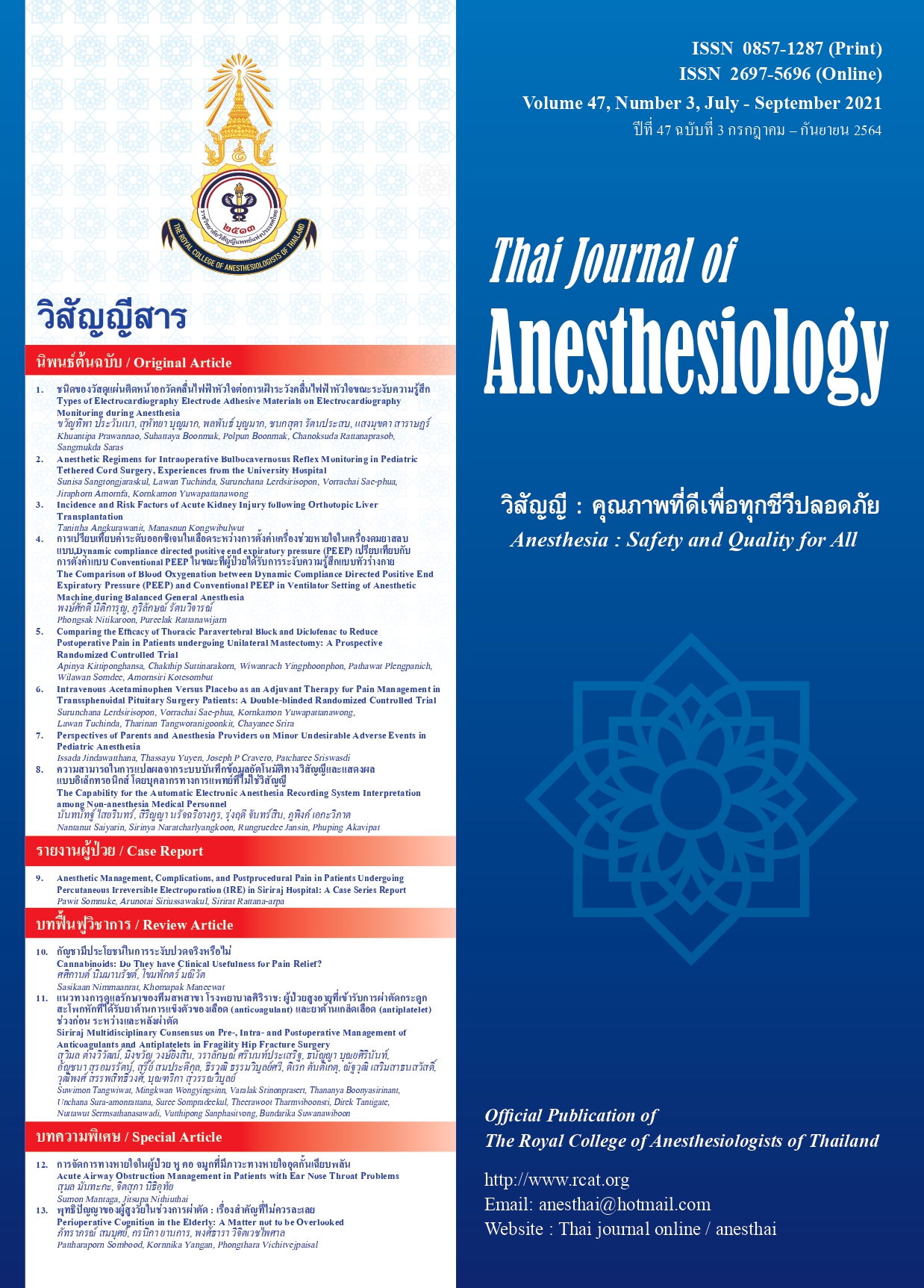The Comparison of Blood Oxygenation between Dynamic Compliance Directed Positive End Expiratory Pressure (PEEP) and Conventional PEEP in Ventilator Setting of Anesthetic Machine during Balanced General Anesthesia
Main Article Content
Abstract
Background: General anesthesia promote impaired pulmonary gas exchange and contribute to postoperative pulmonary complications. Different methods of PEEP titration make the different value of intraoperative oxygenation. Objectives: To study the effect of PEEP titration on the change of intraoperative oxygenation in non-laparoscopic surgery during balanced general anesthesia between dynamic compliance directed PEEP group and conventional PEEP group. Methods: Single-blind randomized controlled trial was done from 1 July 2020 -1 February 2021. After intubation and arterial line insertion. We compared the difference of PaO2 , A-a gradient in arterial blood gas and peak airway pressure at 1st-5th minute and 10th-15th minute between dynamic compliance directed PEEP group and conventional PEEP group. Results: Thirty patients were enrolled in this study. PaO2 at 10th-15th minute in dynamic compliance directed PEEP titration group was higher than the conventional PEEP group (P-value = 0.001). A-a gradient at 10th-15th minute in dynamic compliance directed PEEP group was lesser than the conventional group (P-value = 0.001) Conclusion: Dynamic compliance directed PEEP improve intraoperative oxygenation better than conventional PEEP.
Article Details

This work is licensed under a Creative Commons Attribution-NonCommercial-NoDerivatives 4.0 International License.
References
tidal volume positive end-expiratory pressure versus high
tidal volume zero-positive end-expiratory pressure and
postoperative pulmonary functions in robot-assisted
laparoscopic radical prostatectomy. Med Princ Pract
2017;26:573-78.
2. Serpa Neto A, Hemmes SN, Barbas CS et al. Protective
versus conventional ventilation for surgery. A systematic
review and individual patient data meta-analysis.
Anesthesiology 2015;123:66-78.
3. Mazzinari G, Diaz-Cambonero O, Alonso-Inigo J et al.
Intraabdominal pressure targeted positive end-expiratory
pressure during laparoscopic surgery: an open-label,
nonrandomized, crossover, clinical trial. Anesthesiology
2020;132:667-77.
4. Pereira SM, Tucci MR, Morais CCA, et al. Individual positive
end-expiratory pressure settings optimize intraoperative
mechanical ventilation and reduce postoperative atelectasis.
Anesthesiology 2018;129:1070-81.
5. Hedenstierna G, Tokics L, Scaramuzzo G et al. Oxygenation
impairment during anesthesia: influence of age and body
weight. Anesthesiology 2019;131:46-57.
6. Haliloglu M, Bilgili B, Ozdemir M et al. Low tidal volume
positive end-expiratory pressure versus high tidal volume
zero-positive end-expiratory pressure and postoperative
pulmonary functions in robot-assisted laparoscopic radical
prostatectomy. Med Princ Pract 2017;26:573-78.
7. Girrbach F, Petroff D, Schulz S et al. Individualised positive
end-expiratory pressure guided by electrical impedance
tomography for robot-assisted laparoscopic radical
prostatectomy.Br J Anaesth 2020;125:373-82.
8. Boussarsar M, Thierry G, Jaber S, Roudot-Thoraval F,
Lemaire F, Brochard L. Relationship between ventilatory
settings and barotrauma in the acute respiratory distress
syndrome. Intensive Care Med 2002;28:406-13.


